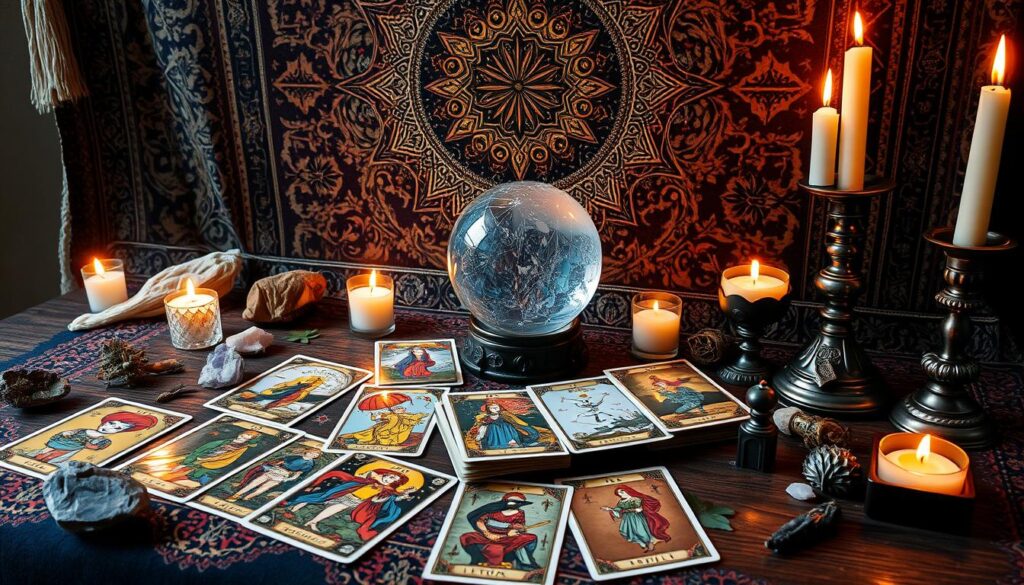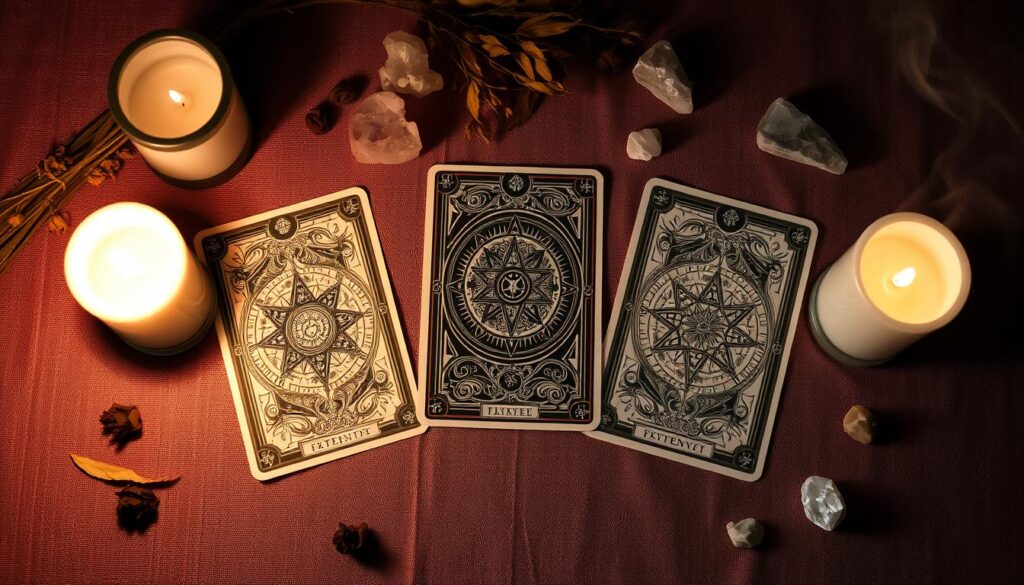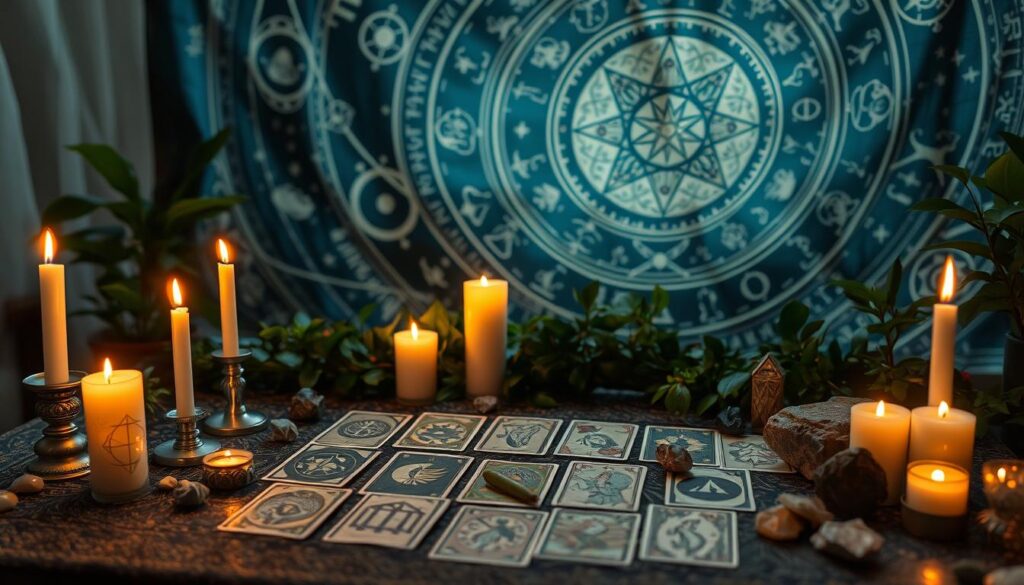
The mystery of tarot card reading has caught people’s attention for hundreds of years. It explores deep secrets through the symbols on each card. Starting in the 15th century, it has become a way for people to understand themselves better, gaining fans all over.
Today, more people want to know about tarot, as a survey by the American Tarot Association shows. They find the mix of ancient wisdom and self-reflection very appealing. If you’re looking for advice, want to learn tarot, or are just curious, this article has helpful information and tips for beginners and experts.
Key Takeaways
- Tarot card reading is an art form with roots tracing back to the 15th century.
- Modern interest in tarot has significantly grown, reflecting its relevance in personal decision making.
- Understanding tarot involves interpreting the symbolism and imagery on the cards.
- Tarot can be used to gain personal insight and guidance.
- This article will guide you through the basics, origins, structure, and common spreads of tarot cards.
- Discover how to start your journey and overcome common myths and misconceptions.
The Origins of Tarot Card Reading
The story of tarot cards started in the 15th century in Italy. At first, they were just for playing games. Over time, they became a tool for telling the future, which is really interesting.
Early History and Development
Tarot cards were first known as “trionfi” or “tarocchi” for gaming. By the 18th century, they took on a mystical role. People began using tarot cards to look into their future, based on studies.
This change started tarot’s history as a divination tool. This history still fascinates many people today.
Tarot in Different Cultures
Tarot traveled around the world and changed along the way. In France, the tarot de Marseille got famous. In England, it was the Rider-Waite deck.
Every culture made tarot their own. Studies show how tarot means different things in different places.
Tarot historians talk about these unique meanings. They show tarot’s rich history and how it keeps changing. This keeps tarot interesting and important in many cultures.
The Structure of a Tarot Deck
Jumping into tarot begins with grasping the tarot deck composition. A traditional deck has 78 cards. These are in two main parts: the Major and Minor Arcana.
The Major Arcana has 22 cards. Each one shows important life changes and lessons. Names like The Fool, The Magician, and The High Priestess are included.
The Minor Arcana counts 56 cards, split into four suits. These are Cups, Pentacles, Swords, and Wands. There are 14 cards in each suit. They tell about everyday events and our life’s complex moments. Together, these suits give a full picture of tarot card meanings.
Tarot symbolism adds depth to the deck. Each card’s imagery and symbols show aspects of our journey. This enriches the cards with meaning and helps in interpretation.
Knowing about tarot deck composition means more than the Major and Minor Arcana split. It’s also valuing the tarot symbolism in each card. This understanding opens up their messages, guiding us.
Understanding the Major Arcana
The Major Arcana cards are very important in tarot readings. They show big life lessons and symbols. Each one of the 22 cards has deep meanings important to the tarot’s story.
Key Cards and Their Meanings
The Fool, The Lovers, and Death are key Major Arcana cards. The Fool stands for beginnings and potential. The Lovers mean relationships and choices. Death is about change and new starts.
These cards mark big moments in life. They tell us about important changes and choices. Knowing their meanings helps understand life’s journey in tarot.
The Journey of the Fool
The Fool’s journey is like our own life story. It starts with The Fool who is ready for adventure. He learns, faces challenges, and grows.
This journey reflects our own growth. Cards like The Magician and The World show different life stages. Each one teaches us about ourselves.
Learning about the Fool’s journey gives us insights. It helps us see our path through the tarot’s eyes.
Exploring the Minor Arcana
The Minor Arcana’s 56 cards shine a light on daily life. Each suit shares unique views and themes. These add depth to our understanding of life’s trials and adventures. We will explore the Cups, Pentacles, Swords, and Wands suits.
The Four Suits Explained
Each Minor Arcana suit represents a slice of human experience. We have the Cups, Pentacles, Swords, and Wands. Diving into each helps us decode card meanings and their impact on us.
- Suit of Cups: Tied to water, it explores our feelings, connections, and gut instincts. Love, happiness, and sadness are central.
- Suit of Pentacles: Echoes earth’s essence, focusing on work, health, and money matters. It speaks to security, fortune, and success.
- Suit of Swords: Reflects air, symbolizing thought, conflict, and choices. Challenges, truth, and clarity are its main themes.
- Suit of Wands: Associated with fire, it looks at creativity, action, and ambition. Inspiration, progress, and fresh starts are key.
Key Cards and Their Interpretations
Important cards in the suits offer deep insights during tarot readings. Knowing these cards and their meanings helps us grasp the Minor Arcana’s messages better.
| Suit | Key Card | Interpretation |
|---|---|---|
| Cups | Ace of Cups | New love starts and emotional fulfillment. |
| Pentacles | Ten of Pentacles | Wealth over time, steady money, and family achievements. |
| Swords | Three of Swords | Loss, deceit, and deep hurt. |
| Wands | King of Wands | Taking the lead on creative efforts and vision. |
Looking at these key cards in their suits offers deeper tarot insights. This knowledge enhances our tarot reading, giving us useful advice for life’s path.
How to Perform a Tarot Reading
Doing a tarot reading can be a deep and revealing journey. It works when you read for yourself or others. Let’s explore the key steps of this captivating activity.
Kick off by setting the right mood. Pick a quiet spot free from distractions. Use candles or incense to make a soothing environment that’s perfect for tarot.
Then, think of a specific question. A clear question leads to more accurate answers. If stuck, look at a tarot book for ideas on making good questions.
Now, shuffle and place the cards. While shuffling, focus on your question. Once ready, pick a tarot layout that suits your needs. You might try the three-card layout or the Celtic Cross.
Understanding the card layout is where the magic happens. Look at a trusted tarot book or listen to your gut to read the cards. Notice any patterns and how the cards relate to each other.
To dig deeper, get advice from tarot pros. They often say to look at the overall story the cards tell. This way, your reading will have more layers and insights.
Common Tarot Card Spreads
Two popular tarot spreads are the three-card spread and the Celtic Cross. They offer deep insights into life’s facets for beginners and experts. Let’s explore their designs and meanings.
The Three-Card Spread
The three-card spread is simple and effective. It looks at past, present, and future. Each card’s place has a special meaning:
- Past: Reflects past events and influences.
- Present: Represents current circumstances.
- Future: Indicates potential outcomes.
This method is good for quick insights. It shows how past actions affect now and later. It’s perfect for straightforward questions.

The Celtic Cross Spread
The Celtic Cross is detailed, giving deep insights. It uses ten positions, each with its own role:
| Position | Meaning |
|---|---|
| 1 | Present situation |
| 2 | Immediate challenge |
| 3 | Foundational issues |
| 4 | Past influences |
| 5 | Goals and aspirations |
| 6 | Near future |
| 7 | Self-perception |
| 8 | Outside influences |
| 9 | Hopes and fears |
| 10 | Final outcome |
The Celtic Cross offers a deep look into one’s life path and future. It is best for those with more tarot experience.
The Symbolism in Tarot Cards
Tarot cards are full of rich tarot symbolism. Each card is like a treasure chest of images that talk to our deeper selves. Every symbol carries a special meaning, like learning a new language where symbols speak.
- The Fool’s Bag: It shows the experiences and potential we carry as we explore the unknown.
- The High Priestess’s Scroll: It talks about secret knowledge and the power of listening to our inner voice.
- The Magician’s Tools: These are tools that symbolize the abilities and power we have to make our wishes real.
- The Lovers’ Apple: Represents the tough choices and temptations that deepen our bonds with others.
To understand tarot symbols, we need to connect with our intuition. From the powerful image of the Tower to the calmness of Temperance, each card invites us to interpret it in our own way. This adds unique insights to our readings.
| Card | Symbol | Meaning |
|---|---|---|
| Death | Scythe | Transformation and new beginnings |
| The Hermit | Lantern | Inner guidance and solitary introspection |
| Judgement | Trumpet | A call to higher awareness and renewal |
While we start with common meanings, interpreting tarot imagery is personal. Tarot readers form their own bond with the symbols, making their readings more meaningful. This mix of classic imagery and personal intuition is what makes tarot a personal guidance tool.
Benefits of Tarot Card Reading
Exploring tarot reading benefits can unlock great value for personal growth and decisions. These cards act as a mirror. They show insights for self-discovery and clarity.

Personal Growth and Insight
Tarot reading aids in personal growth and insight. The symbols on the cards help people understand their inner selves. Many say tarot has made them aware of unseen patterns and behaviors.
This leads to valuable self-reflection. It helps identify areas that need growth and personal improvement.
Guidance and Decision Making
Tarot is great for guidance and decision making. Life’s choices and challenges can be tough. The cards offer new perspectives, showing different options and outcomes.
They bring alternative scenarios and insights. This supports making better decisions. Many claim tarot has aided them in major life choices like career changes and relationships.
“Tarot has been a guiding light for me. It offers clarity whenever I face crossroads in life. Each reading brings a new layer of understanding and helps me see things from different angles.”
– Sarah Alex, avid tarot enthusiast
Tarot reading is invaluable for personal growth and smart decision making. It is a powerful tool for gaining insight and making informed choices in personal matters and tough situations.
Tarot Card Reading for Beginners
Starting to read tarot cards is an exciting journey of discovery and knowing yourself better. Picking your first deck is key when you’re just starting out. It’s best to pick a tarot deck that you really like looking at and feel a connection with. For newbies, the Rider-Waite Tarot Deck and the Modern Witch Tarot Deck are great choices.
Learning tarot means having good resources for guidance. Books like “The Ultimate Guide to Tarot” by Liz Dean are great. So is “Seventy-Eight Degrees of Wisdom” by Rachel Pollack. Also, Biddy Tarot’s website has loads of tutorials to help you get to know the cards.
Here are some tips to get better at tarot:
- Daily Card Draw: Pull one card daily and think about its meaning all day.
- Journaling: Write down your tarot readings and thoughts. This helps you see patterns and understand more.
- Intuition Development: Look closely at the card images to sharpen your intuition.
Getting into tarot also means building a bond with your cards. Take your time to shuffle and touch them. Learning to read tarot cards well takes patience. It’s about slowly gaining knowledge, not rushing.
Below is a handy table comparing beginner tarot decks:
| Tarot Deck | Visual Appeal | Ease of Learning | Price Range |
|---|---|---|---|
| Rider-Waite Tarot Deck | Classic, Symbolic | High | $20 – $25 |
| Modern Witch Tarot Deck | Contemporary, Inclusive | Moderate | $22 – $30 |
| The Wild Unknown Tarot Deck | Artistic, Beautiful | Moderate | $25 – $40 |
By using these resources and practicing a lot, you’ll lay a good foundation for your tarot journey. Remember, all experts started as beginners. Enjoy learning and let your inner voice lead you.
Tarot Card Myths and Misconceptions
Tarot cards are fascinating, yet shrouded in myths. We’re here to unveil the truth. Let’s differentiate between what’s real and what’s not in tarot.
Common Misunderstandings
Many think tarot reading is dark magic. They link it to the occult or evil. In truth, tarot is for self-reflection and guidance. It helps people understand their lives and make thoughtful decisions.
Some believe only gifted folks can read tarot. But actually, anyone can learn. The cards use rich symbols to speak to our intuition, no magic needed.
Debunking the Myths
A big myth is that the Death card means someone will die. In reality, it’s about change and starting fresh. It’s a sign of growth and moving forward.
Another myth is that tarot tells a fixed future. Instead, it shows possible paths based on our choices. Tarot empowers us to shape our destiny, not predict it.
| Myth | Fact |
|---|---|
| Tarot is a form of dark magic | Tarot is a tool for self-reflection and guidance |
| Only psychics can read tarot | Anyone can learn to read tarot with practice |
| The Death card means literal death | The Death card signifies transformation |
| Tarot predicts a fixed future | Tarot offers guidance based on current energies |
Conclusion
We’ve now come to the end of our exploration into tarot card reading. This ancient art is just as amazing and important today as it was long ago. It originally comes from history and is seen differently around the world. The Major and Minor Arcana show us deep insights, making tarot more than a simple card deck.
Tarot’s deck structure is carefully made to show hidden meanings. Different layouts, symbols, and meanings combine to give guidance. Whether new or practiced in tarot, learning and doing readings helps us grow. It helps us make smart choices and understand ourselves better.
Insights from top tarot sources and expert advice show tarot’s lasting importance. It is a way to reflect and find spiritual direction. Tarot lets us see many sides of life. This is just the start—each reading is a chance to find new personal truths. Tarot helps us see both our outer situations and inner thoughts and feelings. This makes it a valued tradition for many.
FAQ
What are the basics of tarot card reading?
Tarot reading gives insight into past, present, and future events. It’s a divination technique providing guidance and self-reflection.
What is the history of tarot cards?
Tarot cards started in 15th century Italy as a game. They became a divination tool over time. They have a significant cultural impact.
How are tarot cards structured?
A tarot deck has 78 cards, split into Major and Minor Arcana. The Major Arcana has 22 cards for life events or spiritual lessons. The Minor Arcana has 56 cards in four suits.
What is the Major Arcana?
The Major Arcana includes 22 cards showing big spiritual lessons. Cards like The Fool and The Lovers are key. They highlight personal growth.
What are the Minor Arcana?
The Minor Arcana has 56 cards in four suits: Cups, Pentacles, Swords, and Wands. Each suit mirrors different life aspects. They cover daily events and experiences.
How do I perform a tarot reading?
To do a tarot reading, make a calm space and ask a clear question. Shuffle the deck and lay out cards. Then, interpret the cards’ symbols and messages.
What are common tarot card spreads?
Popular spreads are the Three-Card and Celtic Cross Spreads. They offer clear insights into past, present, future, and more. Layouts help in organizing the reading.
How important is symbolism in tarot cards?
Symbolism is key in tarot. It shows the deeper meanings of the cards. Knowing the symbols helps with intuitive reading and accuracy.
What are the benefits of tarot card reading?
Tarot helps with growth, self-awareness, and decision-making. It offers new views on challenges. It’s great for introspection and guidance.
How can beginners start with tarot card reading?
Newbies should find a deck they like and use learning aids, like books and online courses. Practice and intuition are crucial for proficiency.
What are some common myths and misconceptions about tarot?
Myths suggest tarot is dark magic, and Death cards mean literal death. These aren’t true. Tarot is for guidance and the Death card means change or new starts.
